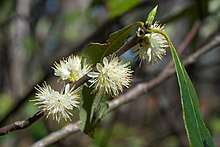Symplocos tinctoria
Symplocos tinctoria (the common sweetleaf,[2] horse-sugar, or yellowwood) is a deciduous or evergreen shrub or tree. It is recognized by pith of twigs chambered; by foliage not notably aromatic when bruised, leaves finely hairy beneath. Shrubs or trees to 17 m tall by 36 cm DBH. The largest first-year twigs are under 3 mm across, terminal buds with acute tip, scales ciliate. Leaves are 7–15 cm long, margin entire or occasionally some teeth on the apical half, with a sweet taste that may be faint in old leaves. It is conspicuous when in flower; flowers opening before new leaves develop, fragrant, in clusters from axils of previous year's leaves or from just above the leaf scars if the leaves have fallen; the petals are creamy yellow to yellow, with one pistil. Fruits nearly cylindrical to ellipsoid drupes 8–12 mm long, with thin pulp and a hard stone containing 1 seed; the tip usually retaining parts of the sepals. Foliage is relished by browsing wildlife. A yellow dye may be obtained from bark and leaves. It flowers Mar to May.[3]
| Symplocos tinctoria | |
|---|---|
 | |
| Scientific classification | |
| Kingdom: | Plantae |
| Clade: | Tracheophytes |
| Clade: | Angiosperms |
| Clade: | Eudicots |
| Clade: | Asterids |
| Order: | Ericales |
| Family: | Symplocaceae |
| Genus: | Symplocos |
| Species: | S. tinctoria |
| Binomial name | |
| Symplocos tinctoria (L.) L'Her. | |
Distribution and habitat
Occasional, plants are often scattered; uncommonly grouped; thin to dense woods of slopes, bluffs, broad-leaf woods of sandy soils, stream borders and stable dunes. Only representative of the genus in North America, mostly in the southeast.
Ecology
The foliage is relished by browsing wildlife.[4]
Uses
A yellow dye was once made from the bark and leaves. The bark was used as a tonic by early American settlers.[4]
References
- "Symplocos tinctoria". NatureServe Explorer. NatureServe. Retrieved 2018-09-23.
- "Symplocos tinctoria". Natural Resources Conservation Service PLANTS Database. USDA. Retrieved 14 July 2016.
- Trees of the Southeastern United States by Wilbur Howard Duncan and Marion Bennett Duncan, 1988, University of Georgia Press, Athens, Georgia, ISBN 0-8203-0954-0
- Little, Elbert L. (1980). The Audubon Society Field Guide to North American Trees: Eastern Region. New York: Knopf. p. 643. ISBN 0-394-50760-6.
Gallery
External links
- http://www.carolinanature.com/trees/syti.html
- http://dendro.cnre.vt.edu/dendrology/syllabus/factsheet.cfm?ID=364
- http://www.rnr.lsu.edu/plantid/species/sweetleaf/sweetleaf.htm
- http://www.wildflower.org/plants/result.php?id_plant=SYTI
- http://www.pfaf.org/user/Plant.aspx?LatinName=Symplocos+tinctoria
- https://plants.ces.ncsu.edu/plants/all/symplocos-tinctoria/
- http://garden.org/plants/view/85584/Sweetleaf-Symplocos-tinctoria/






